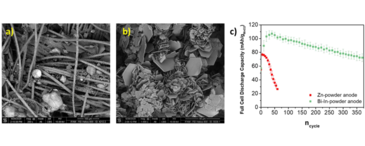Towards Rechargeable Aqueous Zn-Ion Batteries: Development of Stable Zinc Anodes
G. Zampardi, M. Tribbia, J. Glenneberg, F. La Mantia
Mild acidic aqueous Zn-ion batteries (ZIBs) are among the most promising aqueous-based energy storage technologies for stationary applications thanks to their high volumetric energy and power density, high environmentally friendliness and low costs [1]. Such batteries are usually constituted of a positive electrode, which is able to (de-)insert Zn2+ in/from its lattice and a negative electrode based on metallic zinc.
Unfortunately, the commercialization of rechargeable aqueous ZIBs remains hindered mostly because of the non-efficient zinc electrodeposition, caused by: (I) the non-homogeneous deposition of metallic zinc, and (II) the parasitic evolution of gaseous H2, causing the irreversible loss of active zinc. Although various strategies can be found in the literature to increase the homogeneity of the Zn deposits, little attention is generally given to reduce the parasitic, although thermodynamically favored, hydrogen evolution reaction taking place at the zinc-based negative electrode [2]. In order to hinder the parasitic formation of H2, a substrate based on metallic bismuth and indium has been developed to improve the zinc electrodeposition efficiency, thanks to the high overpotential of these two metals toward the hydrogen evolution reaction [2]. In particular, the effect of the metallic substrates has been evaluated in terms of coulombic efficiency, deposition overpotential and electrode morphology. When a full Zn-ion cell has been assembled with the optimized metallic substrates as negative electrode its cycle life increased by ten times with respect of the case when a conventional metallic zinc electrode was used.
Reference
[1] G. Zampardi, F. La Mantia., Nature Communications (2022) 13
[2] M. Tribbia, J. Glenneberg, G. Zampardi, F. La Mantia, Batteries&Supercaps (2022) 5
Giorgia Zampardi graduated in Chemical Engineering at the Universita’ degli Studi di Palermo (Italy) in 2011. She received her Ph.D. in electrochemistry in 2015 from the Ruhr-University Bochum (Germany), focusing on the development of a novel electrochemical analysis to study in operando the solid electrolyte interphase (SEI) in lithium-ion batteries.
She has been postdoctoral fellow at the University of Oxford (United Kingdom), where she investigated the ion insertion reaction occurring within energy storage materials at the single particle level. Since 2019, she is postdoctoral researcher at the University of Bremen (Germany), where she focuses on the development of new, efficient electrode materials and electrolyte-systems for aqueous Zn-ion batteries.



